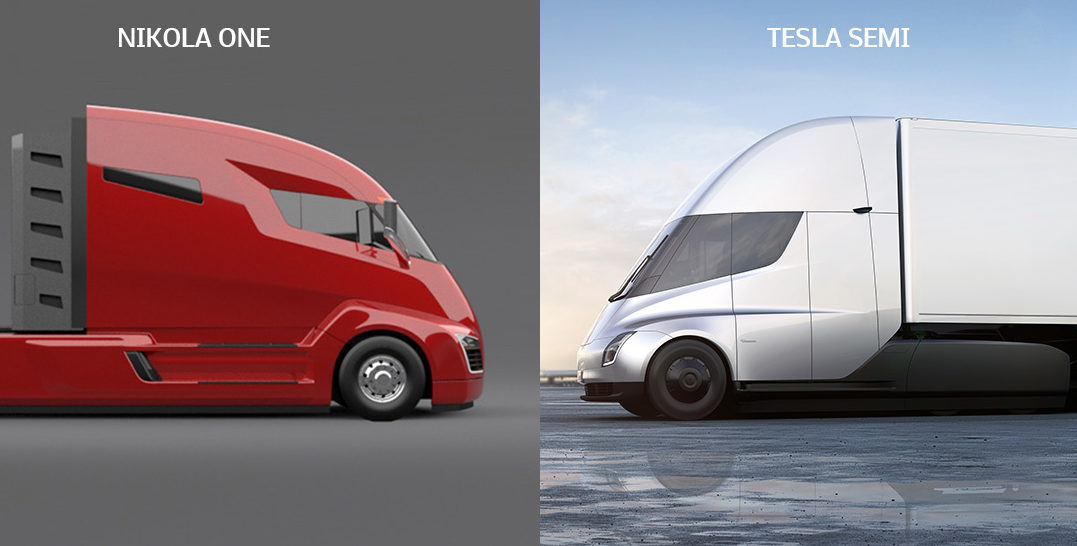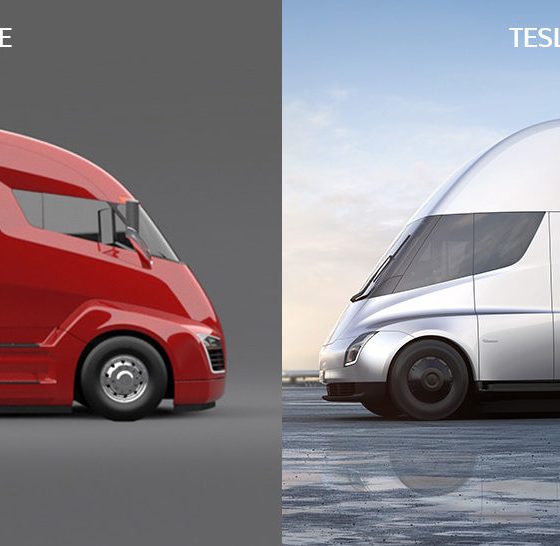

News
Tesla Semi rival Nikola Motors aims to be US’ ‘largest energy consumer’ by 2028
Tesla Semi rival Nikola Motors recently revealed a rather ambitious goal for the future energy consumption of its hydrogen-electric trucks. In a post on its official Twitter page, Nikola announced that in ten years, the company would become the United States’ largest energy consumer.
Nikola pointed out that by 2028, its fleet of hydrogen-electric trucks will be supported by an estimated 820 refilling stations operating across the country. Considering the expected consumption of its long-haulers and estimates that each station will fill 160 trucks daily, each H2 station will likely consume 422 MWh of energy every day. At ~820 refilling stations, Nikola expects its fleet of hydrogen-electric trucks to consume a total of 349 GWh of energy per day.
Within 10 years,@nikolamotor will become the largest energy consumer in America. Estimated 820 stations going online by 2028. Each station fills 160 trucks daily- will consume 422 MWh of renewables (422 MWh X 828 stations = 349 GWh per day) pic.twitter.com/B8Ylovw46H
— Nikola Corporation (@nikolamotor) October 1, 2018
The hydrogen-electric truck startup did clarify that it intends to exclusively utilize renewables for its fleet’s energy consumption. In a follow-up to its initial announcement, the company even noted that it primarily uses solar with wind and hydropower as backups for its operations. Nikola further noted that its energy sources are all renewable, with on-site generation and zero-emissions “from production to consumption.”
Ultimately, Nikola Motors’ recent Twitter announcement gives the company an ambitious target. That said, if the company ramps the construction of its network of H2 refilling stations, its 10-year timeline could prove to be more than enough.
Nikola Motors’ recent announcement about its energy consumption estimates stands as the latest bold declaration from the startup truckmaker. Earlier this year, Nikola issued another bold announcement, seemingly throwing shade at Tesla by stating that all reservations placed for the Nikola One and Nikola Two will be refunded. As an aside, the company further noted in its post that it doesn’t “use (customers’) money to operate (its) business.” Nikola also announced that companies who wish to reserve its future vehicles could do so for free. On May, the company did get a large order for its electric trucks from brewery giant Anheuser-Busch, which ordered 800 units of the hydrogen-electric trucks.
Nikola has since adopted a more unfriendly stance against Tesla. The company has filed a $2 billion lawsuit against the electric car maker alleging that the Tesla Semi violated its design patents for the Nikola One. The hydrogen-electric truck maker lists several aspects of the Tesla Semi that were allegedly copied from the One, including its wraparound windshield, mid-entry door, front fenders, and the electric truck’s aerodynamic body. Nikola further alleged that due to the similarity of the One and the Semi, its brand is at risk due to Tesla’s reputation.
“Tesla’s design has caused confusion among customers. The confusion has diverted sales from Nikola to Tesla. Further, any problems with the Tesla Semi will be attributed to the Nikola One, causing harm to the Nikola brand. For example, Tesla has had problems with its batteries starting fires and its autonomous features causing fatal accidents. Should these problems arise with the Tesla Semi, the market will attribute these problems to Nikola because of the similarities between the two vehicles.”
The US Patent Office granted Tesla its own design patents for the Semi back in August, though, despite the examiner from the agency using the Nikola One as one of the comparison points for the all-electric truck. If Nikola opts to pursue its case against Tesla, it would have to prove that the US Patent Examiner made a mistake — a feat that would be very challenging to accomplish.
Nikola is currently preparing for a three-day event in April 2019, which would involve the unveiling of the pre-production models of its hydrogen-electric trucks, as well as a 2.3-megawatt hydrogen fueling station that would serve as a model for the company’s upcoming network of refilling stations.

Elon Musk
Elon Musk and Tesla AI Director share insights after empty driver seat Robotaxi rides
The executives’ unoccupied tests hint at the rapid progress of Tesla’s unsupervised Robotaxi efforts.

Tesla CEO Elon Musk and AI Director Ashok Elluswamy celebrated Christmas Eve by sharing personal experiences with Robotaxi vehicles that had no safety monitor or occupant in the driver’s seat. Musk described the system’s “perfect driving” around Austin, while Elluswamy posted video from the back seat, calling it “an amazing experience.”
The executives’ unoccupied tests hint at the rapid progress of Tesla’s unsupervised Robotaxi efforts.
Elon and Ashok’s firsthand Robotaxi insights
Prior to Musk and the Tesla AI Director’s posts, sightings of unmanned Teslas navigating public roads were widely shared on social media. One such vehicle was spotted in Austin, Texas, which Elon Musk acknowleged by stating that “Testing is underway with no occupants in the car.”
Based on his Christmas Eve post, Musk seemed to have tested an unmanned Tesla himself. “A Tesla with no safety monitor in the car and me sitting in the passenger seat took me all around Austin on Sunday with perfect driving,” Musk wrote in his post.
Elluswamy responded with a 2-minute video showing himself in the rear of an unmanned Tesla. The video featured the vehicle’s empty front seats, as well as its smooth handling through real-world traffic. He captioned his video with the words, “It’s an amazing experience!”
Towards Unsupervised operations
During an xAI Hackathon earlier this month, Elon Musk mentioned that Tesla owed be removing Safety Monitors from its Robotaxis in Austin in just three weeks. “Unsupervised is pretty much solved at this point. So there will be Tesla Robotaxis operating in Austin with no one in them. Not even anyone in the passenger seat in about three weeks,” he said. Musk echoed similar estimates at the 2025 Annual Shareholder Meeting and the Q3 2025 earnings call.
Considering the insights that were posted Musk and Elluswamy, it does appear that Tesla is working hard towards operating its Robotaxis with no safety monitors. This is quite impressive considering that the service was launched just earlier this year.
Elon Musk
Starlink passes 9 million active customers just weeks after hitting 8 million
The milestone highlights the accelerating growth of Starlink, which has now been adding over 20,000 new users per day.

SpaceX’s Starlink satellite internet service has continued its rapid global expansion, surpassing 9 million active customers just weeks after crossing the 8 million mark.
The milestone highlights the accelerating growth of Starlink, which has now been adding over 20,000 new users per day.
9 million customers
In a post on X, SpaceX stated that Starlink now serves over 9 million active users across 155 countries, territories, and markets. The company reached 8 million customers in early November, meaning it added roughly 1 million subscribers in under seven weeks, or about 21,275 new users on average per day.
“Starlink is connecting more than 9M active customers with high-speed internet across 155 countries, territories, and many other markets,” Starlink wrote in a post on its official X account. SpaceX President Gwynne Shotwell also celebrated the milestone on X. “A huge thank you to all of our customers and congrats to the Starlink team for such an incredible product,” she wrote.
That growth rate reflects both rising demand for broadband in underserved regions and Starlink’s expanding satellite constellation, which now includes more than 9,000 low-Earth-orbit satellites designed to deliver high-speed, low-latency internet worldwide.
Starlink’s momentum
Starlink’s momentum has been building up. SpaceX reported 4.6 million Starlink customers in December 2024, followed by 7 million by August 2025, and 8 million customers in November. Independent data also suggests Starlink usage is rising sharply, with Cloudflare reporting that global web traffic from Starlink users more than doubled in 2025, as noted in an Insider report.
Starlink’s momentum is increasingly tied to SpaceX’s broader financial outlook. Elon Musk has said the satellite network is “by far” the company’s largest revenue driver, and reports suggest SpaceX may be positioning itself for an initial public offering as soon as next year, with valuations estimated as high as $1.5 trillion. Musk has also suggested in the past that Starlink could have its own IPO in the future.
News
NVIDIA Director of Robotics: Tesla FSD v14 is the first AI to pass the “Physical Turing Test”
After testing FSD v14, Fan stated that his experience with FSD felt magical at first, but it soon started to feel like a routine.

NVIDIA Director of Robotics Jim Fan has praised Tesla’s Full Self-Driving (Supervised) v14 as the first AI to pass what he described as a “Physical Turing Test.”
After testing FSD v14, Fan stated that his experience with FSD felt magical at first, but it soon started to feel like a routine. And just like smartphones today, removing it now would “actively hurt.”
Jim Fan’s hands-on FSD v14 impressions
Fan, a leading researcher in embodied AI who is currently solving Physical AI at NVIDIA and spearheading the company’s Project GR00T initiative, noted that he actually was late to the Tesla game. He was, however, one of the first to try out FSD v14.
“I was very late to own a Tesla but among the earliest to try out FSD v14. It’s perhaps the first time I experience an AI that passes the Physical Turing Test: after a long day at work, you press a button, lay back, and couldn’t tell if a neural net or a human drove you home,” Fan wrote in a post on X.
Fan added: “Despite knowing exactly how robot learning works, I still find it magical watching the steering wheel turn by itself. First it feels surreal, next it becomes routine. Then, like the smartphone, taking it away actively hurts. This is how humanity gets rewired and glued to god-like technologies.”
The Physical Turing Test
The original Turing Test was conceived by Alan Turing in 1950, and it was aimed at determining if a machine could exhibit behavior that is equivalent to or indistinguishable from a human. By focusing on text-based conversations, the original Turing Test set a high bar for natural language processing and machine learning.
This test has been passed by today’s large language models. However, the capability to converse in a humanlike manner is a completely different challenge from performing real-world problem-solving or physical interactions. Thus, Fan introduced the Physical Turing Test, which challenges AI systems to demonstrate intelligence through physical actions.
Based on Fan’s comments, Tesla has demonstrated these intelligent physical actions with FSD v14. Elon Musk agreed with the NVIDIA executive, stating in a post on X that with FSD v14, “you can sense the sentience maturing.” Musk also praised Tesla AI, calling it the best “real-world AI” today.








